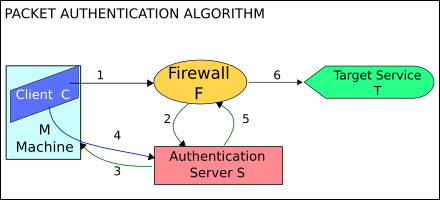The File Transfer Protocol (FTP) is a standard network protocol used for the transfer of computer files between a client and server on a computer network.

In computer networks, a proxy server is a server that acts as an intermediary for requests from clients seeking resources from other servers. A client connects to the proxy server, requesting some service, such as a file, connection, web page, or other resource available from a different server and the proxy server evaluates the request as a way to simplify and control its complexity. Proxies were invented to add structure and encapsulation to distributed systems.
In computing, a stateful firewall is a network firewall that tracks the operating state and characteristics of network connections traversing it. The firewall is configured to distinguish legitimate packets for different types of connections. Only packets matching a known active connection are allowed to pass the firewall.
SOCKS is an Internet protocol that exchanges network packets between a client and server through a proxy server. SOCKS5 additionally provides authentication so only authorized users may access a server. Practically, a SOCKS server proxies TCP connections to an arbitrary IP address, and provides a means for UDP packets to be forwarded.

A captive portal is a web page accessed with a web browser that is displayed to newly connected users of a Wi-Fi network before they are granted broader access to network resources. Captive portals are commonly used to present a landing or log-in page which may require authentication, payment, acceptance of an end-user license agreement or an acceptable use policy, or other valid credentials that both the host and user agree to adhere by. Captive portals are used for a broad range of mobile and pedestrian broadband services - including cable and commercially provided Wi-Fi and home hotspots. A captive portal can also be used to provide access to enterprise or residential wired networks, such as apartment houses, hotel rooms, and business centers.

In computer networking, port forwarding or port mapping is an application of network address translation (NAT) that redirects a communication request from one address and port number combination to another while the packets are traversing a network gateway, such as a router or firewall. This technique is most commonly used to make services on a host residing on a protected or masqueraded (internal) network available to hosts on the opposite side of the gateway, by remapping the destination IP address and port number of the communication to an internal host.
Internet security is a branch of computer security specifically related to not only the Internet, often involving browser security and the World Wide Web, but also network security as it applies to other applications or operating systems as a whole. Its objective is to establish rules and measures to use against attacks over the Internet. The Internet represents an insecure channel for exchanging information, which leads to a high risk of intrusion or fraud, such as phishing, online viruses, trojans, worms and more.
In computer networking, port knocking is a method of externally opening ports on a firewall by generating a connection attempt on a set of prespecified closed ports. Once a correct sequence of connection attempts is received, the firewall rules are dynamically modified to allow the host which sent the connection attempts to connect over specific port(s). A variant called single packet authorization exists, where only a single "knock" is needed, consisting of an encrypted packet.
iptables is a user-space utility program that allows a system administrator to configure the tables provided by the Linux kernel firewall and the chains and rules it stores. Different kernel modules and programs are currently used for different protocols; iptables applies to IPv4, ip6tables to IPv6, arptables to ARP, and ebtables to Ethernet frames.

Linux Virtual Server (LVS) is load balancing software for Linux kernel–based operating systems.
FTPS is an extension to the commonly used File Transfer Protocol (FTP) that adds support for the Transport Layer Security (TLS) and, formerly, the Secure Sockets Layer cryptographic protocols.
The Yahoo! Messenger Protocol (YMSG) is the underlying network protocol used by the Yahoo! Messenger instant messaging client. Yahoo! Instant Messager supports many features beyond just messaging, including off-line messaging, file transfer, chat, conferencing, voice chat, webcams and avatars.

LogMeIn Hamachi is a virtual private network (VPN) application written by Alex Pankratov in 2004. It is capable of establishing direct links between computers that are behind Network address translation ("NAT") firewalls without requiring reconfiguration ; in other words, it establishes a connection over the Internet that emulates the connection that would exist if the computers were connected over a local area network ("LAN").
Hole punching is a technique in computer networking for establishing a direct connection between two parties in which one or both are behind firewalls or behind routers that use network address translation (NAT). To punch a hole, each client connects to an unrestricted third-party server that temporarily stores external and internal address and port information for each client. The server then relays each client's information to the other, and using that information each client tries to establish direct connection; as a result of the connections using valid port numbers, restrictive firewalls or routers accept and forward the incoming packets on each side.
In computing, Microsoft's Windows Vista and Windows Server 2008 introduced in 2007/2008 a new networking stack named Next Generation TCP/IP stack,
to improve on the previous stack in several ways.
The stack includes native implementation of IPv6, as well as a complete overhaul of IPv4. The new TCP/IP stack uses a new method to store configuration settings that enables more dynamic control and does not require a computer restart after a change in settings. The new stack, implemented as a dual-stack model, depends on a strong host-model and features an infrastructure to enable more modular components that one can dynamically insert and remove.
Zeroshell is a small open-source Linux distribution for servers and embedded systems which aims to provide network services. Its administration relies on a web-based graphical interface; no shell is needed to administer and configure it. Zeroshell is available as Live CD and CompactFlash images, and VMware virtual machines.

SoftEther VPN is free open-source, cross-platform, multi-protocol VPN client and VPN server software, developed as part of Daiyuu Nobori's master's thesis research at the University of Tsukuba. VPN protocols such as SSL VPN, L2TP/IPsec, OpenVPN, and Microsoft Secure Socket Tunneling Protocol are provided in a single VPN server. It was released using the GPLv2 license on January 4, 2014. The license was switched to Apache License 2.0 on January 21, 2019.
Port Control Protocol (PCP) is a computer networking protocol that allows hosts on IPv4 or IPv6 networks to control how the incoming IPv4 or IPv6 packets are translated and forwarded by an upstream router that performs network address translation (NAT) or packet filtering. By allowing hosts to create explicit port forwarding rules, handling of the network traffic can be easily configured to make hosts placed behind NATs or firewalls reachable from the rest of the Internet, which is a requirement for many applications.








